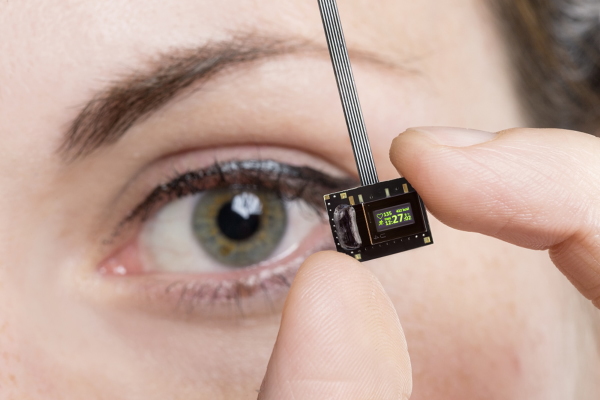
The history of holography is filled with a wide assortment of innovative applications. These range from industrial and research applications in non-destructive testing, holographic art for displays in private and gallery settings, and military optical applications through to anti-counterfeit and brand protection, all of which is represented by the IHMA. In the current high technology world, holography in the widest sense continues to evolve and innovate into further areas of application.
This evolution is not confined to the technology alone, as the breadth of what is now termed ‘holography’ in the eyes of both the wider industry and the public continues to evolve too. Although areas such as 3D display and 3D projection at events are often not holographic in the true sense of the word, they extend the use of the term in public perception.
However, behind the scenes there is a new field emerging that is poised to take real holography using diffractive structures into wider penetration of industrial and consumer applications in wearable devices through the use of holographic optical elements.
Holographic optical elements
Holographic optical elements (HOEs) have a long history as a route to light weight, flexible and compact optics. Head up displays are one example of an application area, initially in military fighter jet cockpits. Wearable technology applications now look set to trigger a resurgence of interest in these holographic optical elements.
Whilst HOEs have been with us for some time, they can now take on the advantages of new technologies already in use in the banknote and identity protection sectors, for two broad categories - software and hardware.
One significant advance of recent years is in digital origination, now well established and developed in the use of holography in the anti-counterfeit, product and brand protection sectors. In classical holography a complex pattern is formed by interference between two wavefronts and recorded in a photosensitive material. The field of digital origination has the capacity to extend this further, computing the diffractive structure directly in software to produce hitherto unattainable optical effects from patterns written directly onto or into a material.
There have also been a number of material science developments that have aided the integration of holographic elements into optical assemblies, and these looks set to continue. The anti-counterfeiting and brand protection industry has been in the forefront of the adoption of holographic elements in or on plastic substrates and new developments in waveguide optics, and methods have evolved with particular significance for the display industry. A combination of this expertise is now being adopted and adapted for head mounted wearable devices.
The concept of head mounted wearables
HOEs look set to emerge in a new form factor as a facilitating technology for head mounted displays for virtual, augmented and mixed reality (VR, AR and MR). These span the application spectrum from in-vision display to augment warehouse workers to the virtual reality of the metaverse, an immersive 3D alternative reality.
Head mounted wearables incorporating displays in the field of view are required for all these applications to create a comfortable and high-resolution image for the viewer. However, the current technologies have a number of problems that are yet to be solved. Holography, in the form of the HOEs described above, could provide a key part of the solution.
The optical issues can be summarised as follows. Images generated by a display must be somehow transferred into the field of view of the eyes, which is very wide. The brightness and optical attributes such as persistence and flicker must be suitable for the application. And the synchronisation and focus of the two eye displays must be such that it reduces visual fatigue and nausea.
To this must be added some practical needs. The wearable will be head mounted so must be low weight and low power, and affordable at the price point of the application. It is in these areas that HOEs look set to achieve success.
A strong candidate for this optical configuration is to generate the image on a micro-OLED screen, couple this into a flexible waveguide and in turn couple the output into the field of view of the eyes. From a business perspective, the field has already seen some acquisition activity and we look set to see holographic knowledge and capabilities being of significant interest in this area.
The future
On-line interaction is one of the legacies of the pandemic, but the desktop or smartphone screens we have used for this are probably only one step on the road. For various social and commercial reasons, a mass market need looks set to be constructed for the next generation of smart, mobile devices. Head mounted wearables are appearing as a strong candidate, with holography playing a significant role in the implementation.
There are other hardware technologies that will aid the integration of HOEs into head mounted wearables. Printed optical features look set to feature in this both on micro and macro scales. Wholly printed lenses on an eye and pixel scale are technologies that are already established in ophthalmic and display optics.
These technologies could provide further opportunities across a number of sectors. Printed optical features could find further application in the field of product and brand protection. In addition to opportunities in consumer and industrial devices, these head mounted wearables could unlock further opportunities across sectors. It’s clear that holography and holographic techniques look set to play a significant part in this future.


Dr Paul Dunn is chair of the International Hologram Manufacturers Association (IHMA)
The IHMA (www.ihma.org) is made up of more than 80 of the world's leading hologram companies. Members include the leading producers and converters of holograms for banknote security, ID cards and passports, other secure documents, brand protection, packaging, graphics and other commercial applications around the world, and actively cooperate to maintain the highest professional, security and quality standards.
©
SecuringIndustry.com






